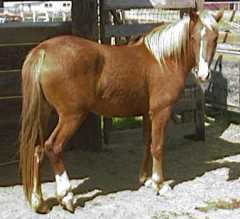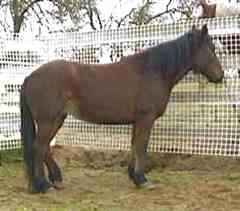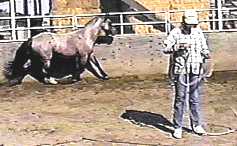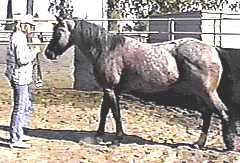My Wild Horse is Home;
|

|
|
Here is an all too familiar scenario. An adopter acquires a horse
and brings it home. Armed with pamphlets, suggested reading materials and
helpful advice, the new adopter is looking at a pretty wary animal
in a corral and the horse doesn't look all that friendly. At the wild
horse adoption the trainer in the round pen seemed to make it all
look so easy. So the adopter is thinking, "How do I get those results and
where do I start?"
Adopted wild horses are bright and very trainable but for most of these animals their experiences with humans have not been that social and rewarding. They've been herded, processed, placed in chutes, vaccinated, had blood drawn, been freeze branded and in some cases gelded. For the most part their positive social lives have consisted solely of interaction with other horses and about the only good human was the one in the back of the truck that threw hay each day. These experiences come on top of pretty scary contacts with man in the wild. In addition horses are prey animals and humans are predators. When one thinks about all of these factors, it should become clear why your adopted horse doesn't warm up to you like a puppy from the pound. While this kind of scenario is an honest reality check, it doesn't mean that your adopted horse won't become gentle, happy in his environment, socially attached to you and if treated right become a more loyal partner than most domestic horses. It's just that each horse has a history as well as strong natural instincts. You can ignore those instincts and increase the horse's stress and discomfort, however the smart handler sets the situation up to use those instincts in a way that that advances the gentling process and avoids situations that generates fear and defensiveness.
Return to LRTC Help DeskImportant Note: If you take on the project of developing an untrained horse, everybody will want to give you advice. Don't act on any advice, including the ideas offered in this site, unless it makes sense to you and fits your individual situation. Your abilities and the sensitivities of your horse(s) may differ from the examples given. Be alert and rational with your actions so neither you nor your horse will get hurt. This information is offered as illustrations of what we do and the reader must apply common sense since he or she is solely responsible for his or her actions. Happy trails!Press "Back" to return to the page which brought you hereGo to KBR Training SectionGo to LRTC Wild Horse MentorsGo to KBR World of Wild Horses & BurrosGo to other Wild Horse LinksGo To
|



